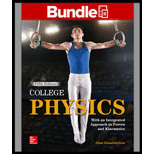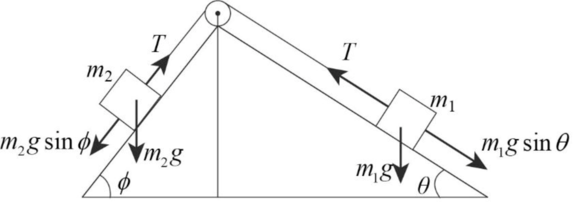
(a)
The velocity of the blocks moving after they travel
(a)
Answer to Problem 133P
The velocity of the blocks moving after they travel
Explanation of Solution
Write the expression for the distance travelled by the first block.
Here,
Write the expression for the distance travelled by the second block.
Here,
Since the mass
Write the expression for the conservation law of energy.
Here,
Use equation (I) and (II) in (III) to solve for
Conclusion:
Substitute
Therefore, the velocity of the blocks moving after they travel
(b)
The acceleration and velocity of each of the blocks.
(b)
Answer to Problem 133P
The acceleration of each of the blocks is
Explanation of Solution

Write the expression for the Newton’s second law of motion for the mass
Here,
Write the expression for the Newton’s second law of motion for the mass
Here,
Use equation (VI) to solve for
Use equation (VII) in (V) to solve for
Initially the blocks are kept stationary and the initial velocity is zero.
Write the equation of motion to solve for the
Here,
Conclusion:
Substitute
Substitute
Therefore, the acceleration of each of the blocks is
Want to see more full solutions like this?
Chapter 6 Solutions
COLLEGE PHYSICS (LOOSELEAF)-W/CONNECT
 College PhysicsPhysicsISBN:9781305952300Author:Raymond A. Serway, Chris VuillePublisher:Cengage Learning
College PhysicsPhysicsISBN:9781305952300Author:Raymond A. Serway, Chris VuillePublisher:Cengage Learning University Physics (14th Edition)PhysicsISBN:9780133969290Author:Hugh D. Young, Roger A. FreedmanPublisher:PEARSON
University Physics (14th Edition)PhysicsISBN:9780133969290Author:Hugh D. Young, Roger A. FreedmanPublisher:PEARSON Introduction To Quantum MechanicsPhysicsISBN:9781107189638Author:Griffiths, David J., Schroeter, Darrell F.Publisher:Cambridge University Press
Introduction To Quantum MechanicsPhysicsISBN:9781107189638Author:Griffiths, David J., Schroeter, Darrell F.Publisher:Cambridge University Press Physics for Scientists and EngineersPhysicsISBN:9781337553278Author:Raymond A. Serway, John W. JewettPublisher:Cengage Learning
Physics for Scientists and EngineersPhysicsISBN:9781337553278Author:Raymond A. Serway, John W. JewettPublisher:Cengage Learning Lecture- Tutorials for Introductory AstronomyPhysicsISBN:9780321820464Author:Edward E. Prather, Tim P. Slater, Jeff P. Adams, Gina BrissendenPublisher:Addison-Wesley
Lecture- Tutorials for Introductory AstronomyPhysicsISBN:9780321820464Author:Edward E. Prather, Tim P. Slater, Jeff P. Adams, Gina BrissendenPublisher:Addison-Wesley College Physics: A Strategic Approach (4th Editio...PhysicsISBN:9780134609034Author:Randall D. Knight (Professor Emeritus), Brian Jones, Stuart FieldPublisher:PEARSON
College Physics: A Strategic Approach (4th Editio...PhysicsISBN:9780134609034Author:Randall D. Knight (Professor Emeritus), Brian Jones, Stuart FieldPublisher:PEARSON





